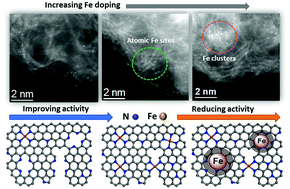High-performance fuel cell cathodes exclusively containing atomically dispersed iron active sites†
Abstract
Platinum group metal-free (PGM-free) catalysts for the oxygen reduction reaction (ORR) with atomically dispersed FeN4 sites have emerged as a potential replacement for low-PGM catalysts in acidic polymer electrolyte fuel cells (PEFCs). In this work, we carefully tuned the doped Fe content in zeolitic imidazolate framework (ZIF)-8 precursors and achieved complete atomic dispersion of FeN4 sites, the sole Fe species in the catalyst based on Mößbauer spectroscopy data. The Fe–N–C catalyst with the highest density of active sites achieved respectable ORR activity in rotating disk electrode (RDE) testing with a half-wave potential (E1/2) of 0.88 ± 0.01 V vs. the reversible hydrogen electrode (RHE) in 0.5 M H2SO4 electrolyte. The activity degradation was found to be more significant when holding the potential at 0.85 V relative to standard potential cycling (0.6–1.0 V) in O2 saturated acid electrolyte. The post-mortem electron microscopy analysis provides insights into possible catalyst degradation mechanisms associated with Fe–N coordination cleavage and carbon corrosion. High ORR activity was confirmed in fuel cell testing, which also divulged the promising performance of the catalysts at practical PEFC voltages. We conclude that the key factor behind the high ORR activity of the Fe–N–C catalyst is the optimum Fe content in the ZIF-8 precursor. While too little Fe in the precursors results in an insufficient density of FeN4 sites, too much Fe leads to the formation of clusters and an ensuing significant loss in catalytic activity due to the loss of atomically dispersed Fe to inactive clusters or even nanoparticles. Advanced electron microscopy was used to obtain insights into the clustering of Fe atoms as a function of the doped Fe content. The Fe content in the precursor also affects other key catalyst properties such as the particle size, porosity, nitrogen-doping level, and carbon microstructure. Thanks to using model catalysts exclusively containing FeN4 sites, it was possible to directly correlate the ORR activity with the density of FeN4 species in the catalyst.



 Please wait while we load your content...
Please wait while we load your content...